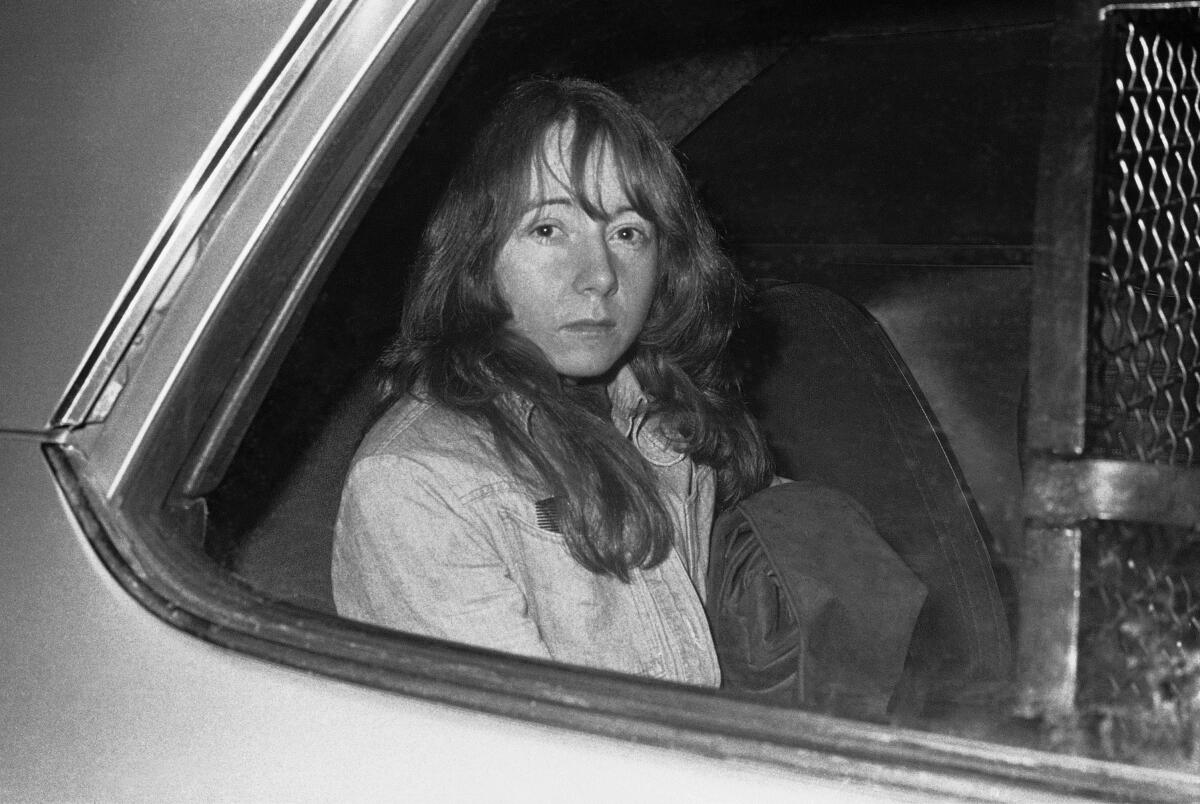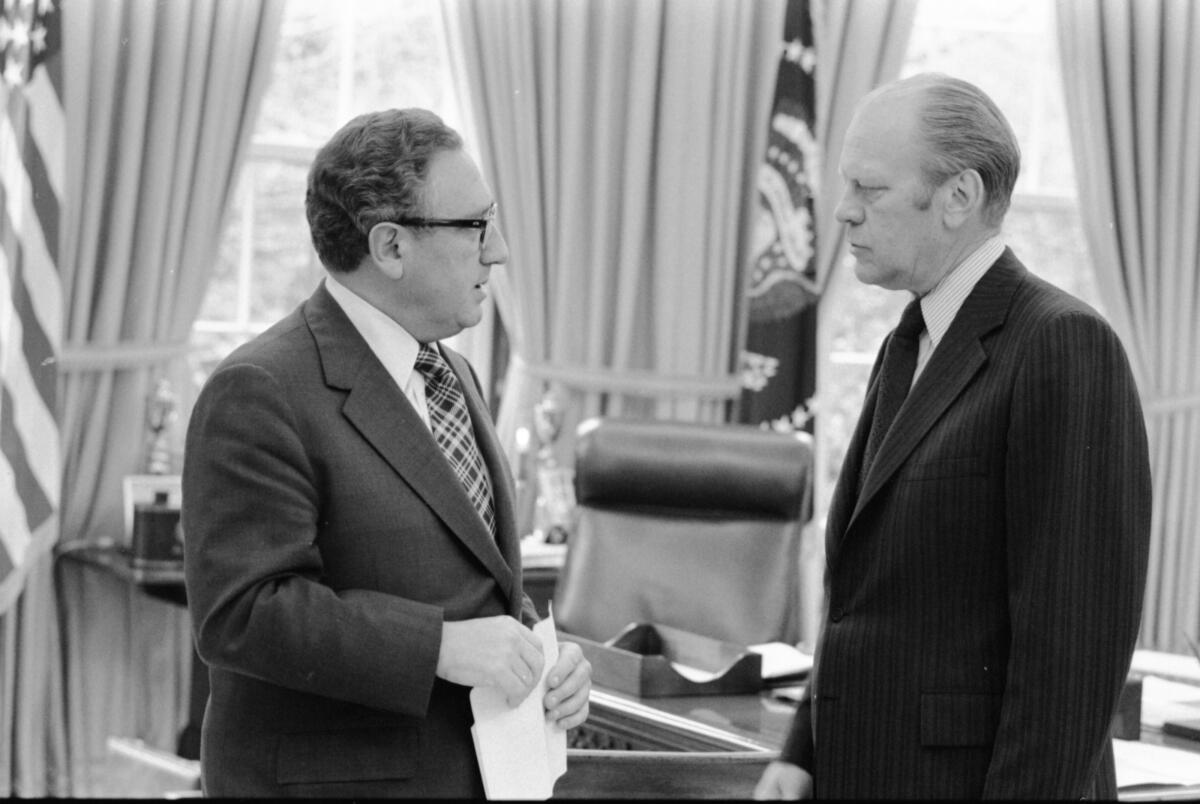Before Trump, President Ford survived 2 assassination attempts in 3 weeks in California

- Share via
- In September, 1975, President Ford survived two assassination attempts in California.
- There are parallels to the assassination attempts of former President Trump.
Nine weeks after a gunman tried to kill Donald Trump in Pennsylvania, the FBI said the former president appeared to be the target of another assassination attempt, at a golf course in Palm Beach on Sunday.
He was not hurt. But the back-to-back incidents have historic echoes. In September 1975, President Ford escaped two assassination attempts, one in Sacramento and the other in San Francisco.
As with this summer’s political violence, the attempts to kill Ford shocked the nation.
Here is a retrospective of what happened taken from the pages of the Los Angeles Times.
Sept. 5, 1975 | Sacramento
Lynette “Squeaky” Fromme, a follower of Charles Manson, was 26 when she pointed a pistol at Ford in Sacramento. Secret Service agents grabbed her, and Ford was unharmed.
She was convicted Nov. 26, 1975, of attempting to assassinate the president. She was released from prison in 2009 after 34 years.
In testimony from 1975 that was released decades later, Ford calmly described seeing a woman in a bright red dress at Capitol Park in Sacramento and thinking she was drawing near to shake his hand.
“My first impression was that she wanted to come closer and extend — I thought at the time — a hand to shake, or to say something to me,” Ford says on the tape.
Then, he said, he noticed the gun, a .45-caliber Colt semiautomatic pistol, adding that “the weapon was large.”
The Times’ Christopher Goffard looked back on the case earlier this year.
He talked to witnesses in Sacramento as well as delved into Fromme’s obsession with Manson.
Journalist Jess Bravin, author of “Squeaky: The Life and Times of Lynette Alice Fromme,” told Goffard that Fromme maintained a kind of religious devotion to Manson until his death. She told Bravin she had gone to the park that day uncertain about what she would do.
“She had no personal feelings about [Ford] one way or another,” Bravin said. “She was very angry at the system and what she felt was the environmental degradation. Ford was coming to speak to businessmen in Sacramento. She felt he was destroying the redwoods.”
In 1987, after hearing a rumor that Manson was dying of cancer, she slipped away from a minimum-security federal prison in West Virginia with the hope, she said, of being near him. She was captured two miles away.
She was released on parole in 2009.

Sept. 22, 1975 | San Francisco
Sara Jane Moore, an accountant and a divorced mother of four, fired a gun at Ford on Sept. 22, 1975, as the president was leaving a speaking engagement at the St. Francis Hotel in downtown San Francisco.
Her single shot from a .38-caliber revolver missed Ford by several feet after Oliver Sipple, a disabled Vietnam War veteran, grabbed her arm and pulled her down.
San Francisco police had dealt with Moore in the past and viewed her as a potential threat to the president.
Two days before the attempted assassination, they arrested her on the street with a .44-caliber revolver in her handbag and boxes of ammunition in her car.
Police alerted the Secret Service, who interviewed and released her. Less than 48 hours later, she purchased her .38 from a friend, stationed herself outside the St. Francis in a crowd of several thousand and tried to shoot her way into history.
Before she fired at Ford, Moore had received psychiatric treatment several times. Her attorneys were preparing an insanity defense. She pleaded guilty over their objections.
After she was sentenced, Moore expressed mixed feelings about her actions.
“Am I sorry I tried?” she said. “Yes and no. Yes, because it accomplished little except to throw away the rest of my life. ... And, no, I’m not sorry I tried, because at the time it seemed a correct expression of my anger.”
Sipple, the former Marine who subdued her, said his life was ruined by publicity about him in the wake of his heroic act.
Retired from the Marines on a disability pension, Sipple was gay — a fact that he said his relatives never knew until it came out in the newspapers.
He filed a $15-million lawsuit for invasion of privacy against seven newspapers, including The Times. A judge rejected it. Sipple died in 1989 at the age of 47. His health had deteriorated and he was drinking heavily.
That year, Ford wrote a letter saying he was “forever grateful” for the former Marine’s action in averting the assassination.
“I strongly regretted the problems that developed for him following this incident,” said Ford’s letter, which was dated Feb. 14 and addressed “To the friends of Oliver Sipple.” “It saddened me to learn the circumstances of his death.”
Moore was released on parole in 2008.

Assessing those moments in history
In 2006, The Times looked back on both assassination attempts and found they were becoming footnotes in history. Historians weighed in on what they meant.
Both plots were symptoms of the 1970s, the “goofiest decade of the century for California ... in terms of its sheer ominous weirdness,” said Kevin Starr, USC history professor and state librarian emeritus.
“Moore’s style was middle-class, whereas Squeaky Fromme was a genuine cultist. Moore represented the individual derangement of the period and Squeaky the social derangement,” Starr said.
The assassination attempts — Fromme’s in Sacramento and Moore’s in San Francisco — also contributed to “an atmosphere of lawlessness” in Northern California, Starr said, compounded by such 1970s events as the Patty Hearst kidnapping, the slaying of San Francisco Mayor George Moscone and the mass suicide of the Jonestown cultists.
Others say the acts symbolized an unraveling of American society in the aftermath of Watergate and the Vietnam War.
“A lot of people were rolling around unmoored, finding a reason to believe there was a political or conspiratorial explanation for their inner upheaval and concluding if they could only act on their impulse, they could save the world,” said Todd Gitlin, professor of journalism and sociology at Columbia University and a former leader of the Students for a Democratic Society whose books include “The Sixties: Years of Hope, Days of Rage.”
More to Read
Get the L.A. Times Politics newsletter
Deeply reported insights into legislation, politics and policy from Sacramento, Washington and beyond. In your inbox twice per week.
You may occasionally receive promotional content from the Los Angeles Times.










